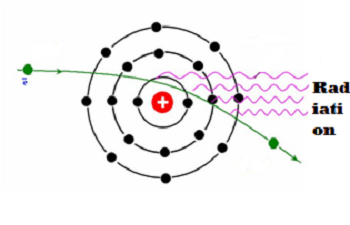Production or origin of Continuous X rays
Last time, we have discussed about the origin of name of x rays that is why x rays are known as x rays.
Today, we will discuss how x rays are produced? It is proved that whenever fast moving electrons strike a target material of high atomic number and high melting point x rays are produced. But what happen after the collision of electrons? Why and how x rays are produced then? Let us discuss it:
Consider any target material of high atomic number and high melting point. We all know that electrons in an atom placed in different shells or orbits. When fast moving electrons under the influence of high potential difference (that may vary from 10000 volts and above) strike the target material, most of the electrons will heat the target and almost 10% of the electrons will lead to production of x rays.
Protons and neutrons are placed in nucleus of the atom so nucleus is heavily positively charge. When fast moving electrons will pass through the target material, it will be attracted towards the positive nucleus (see figure). The velocity of electrons will decrease. Thus there will be rate of change of velocity means there will be retardation or negative acceleration. As per the classical physics, whenever electrons retard, energy will be released in the form of radiation.

This is also known as Bremsstrahlung (Braking or retarding Radiation), Brems– to brake and strahlung-radiation. In this case, the radiation released will have energy in the range of energy of X rays. This is known as continuum or continuous x rays
Let us derive the Duane – Hunt law also:
- Let v1 – initial velocity of electron
- Thus E1 = ½ mv12– initial energy
- Let v2 – final velocity
- Thus E2 = ½ mv22– final energy
- Thus change in energy due to retardation
- ½ mv12 – ½ mv22 = hγ
- Where h is Planck’s constant and γ is frequency of radiation emitted
If electrons suddenly stopped that is v2 = 0, then take v1 = v, then we will get x ray of maximum energy.
Then above equation becomes:
½ mv2 = hγmax
- Also as electrons gain energy or move due to potential difference (V), thus
- ½ mv2 = eV
- Comparing above equations
- hγmax = eV
- or hc/λmin = eV
- or λmin = hc/eV
- = 12400/V angstrom
- This is Duane-Hunt law or limit
It shows that wavelength of emitted x rays depends upon the potential difference only. More the potential difference, lesser will be the wavelength or vice versa.
I will discuss the graph or continuous x rays in my next article with characteristic x rays. If you have any doubt, please share as comment.
You can also see our youtube video about continuous x rays here: